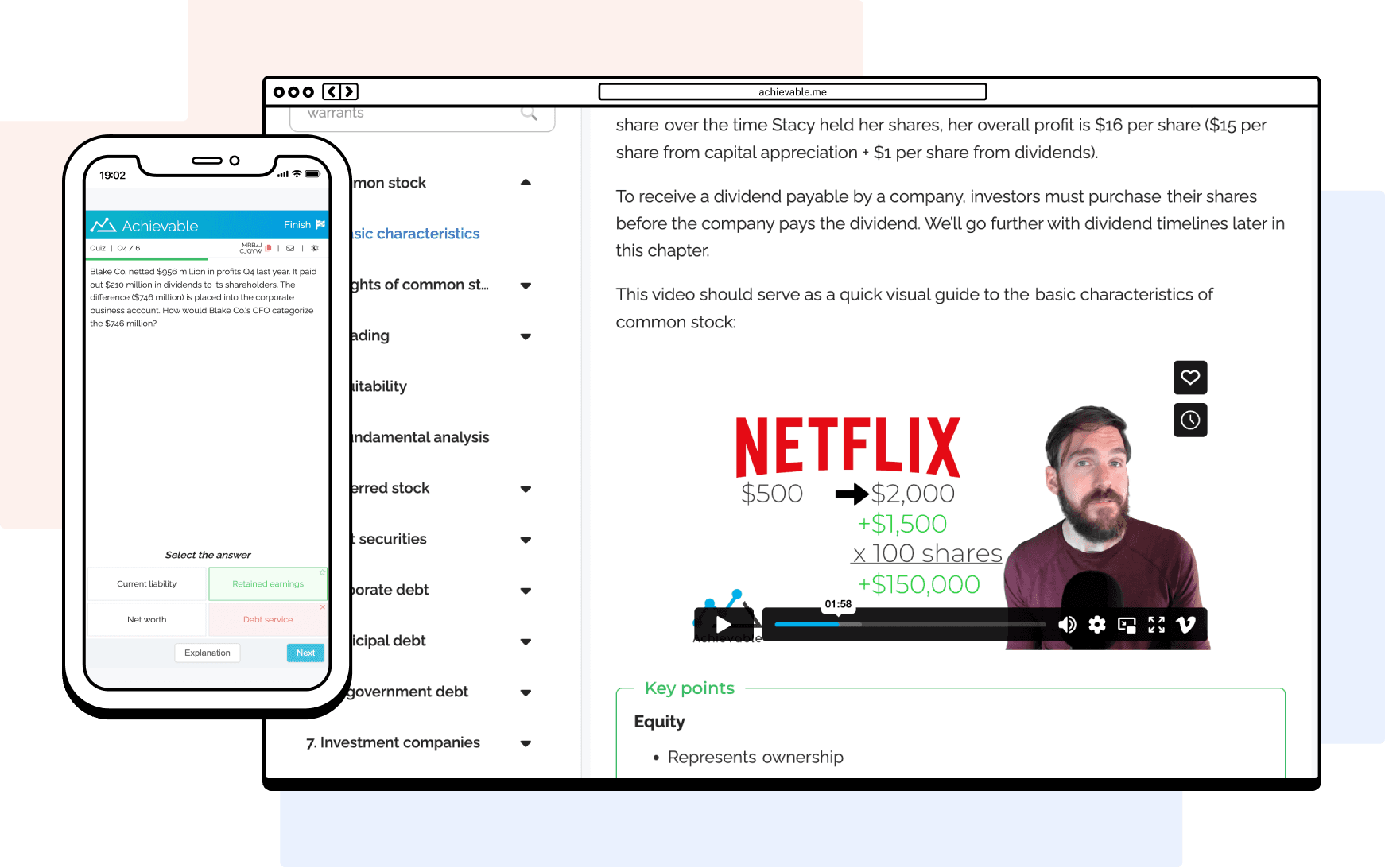
FINRA SIEExam information
Exam information
What it is, what's tested, and how it's scored.

SIE exam details
The SIE covers the fundamentals that you'll need for any role in finance, establishing a solid foundation for your career path.
The SIE exam is hosted by FINRA and costs $80 to register. Participants have 1 hour 45 minutes to answer 75 multiple-choice questions. The passing score is 70% (53/75).

FINRA's SIE exam summary
Knowledge of Capital Markets
16%
12 questions
The basics, laws, and regulations of the financial markets. You'll need to know the primary and secondary markets, the regulators (SEC and FINRA), and their rules (Act of 1933, etc).
Understanding Products and their Risks
44%
33 questions
The products of the financial markets, which include stocks, bonds, mutual funds, ETFs, and options. You'll need to know what these products are, the risks of investing in them, and how they benefit investors.
Understanding Trading, Customer Accounts and Prohibited Activities
31%
23 questions
How customers buy and sell securities in their accounts. You'll need to know different types of orders and accounts, how those orders are entered into the market, and the regulations that govern these activities.
Overview of Regulatory Framework
9%
7 questions
How financial professionals operate in their jobs and the rules that govern their activities. You'll need to know FINRA and SEC rules, ethics of working with clients, and general procedures for financial professionals.

Achievable SIE content outline
1
Common stock
All things related to common stock, including rights of stockholders, stock markets, benefits & risks, and fundamental analysis. Various equity-related investments like ADRs, rights, warrants, and tender offers are also discussed.
2
Preferred stock
Characteristics, features, benefits, and risks of preferred stock. Interest rates, their influence on the financial markets, and how they impact preferred stock market prices are additionally covered.
3
Bond fundamentals
The foundations of debt securities, which are the most commonly traded investment in the financial markets. Topics covered include interest rates, bond characteristics, the debt markets, yields, and benefits, and risks.
4
Corporate debt
Why corporations borrow money, how they do it, and different types of debt securities they offer. The bond markets and bank products like banker's acceptances and CDs are also part of this chapter.
5
Municipal debt
The basics of municipal government products and why states, cities, and political subdivisions borrow money. Mainly focusing on general obligation (G.O.) bonds and revenue bonds, you'll learn how your local government finances its activities.
6
US government debt
The essentials of securities issued by the U.S. Treasury and federal agencies. The Federal Reserve, its monetary policy, and how it influences the economy is also examined.
7
Investment companies
What an investment company is, how they operate, and the rules and regulations of the Investment Company Act of 1940. Mutual funds, closed-end funds, exchange traded funds (ETFs), and unit investment trust (UITs) are specifically discussed in detail.
8
Alternative pooled investments
Products that work similarly to investment companies, but fall outside their definition. Primarily focusing on real estate investment trusts (REITs), hedge funds, and direct participation programs.
9
Options
The fundamental elements of options, which lock in future transaction prices. Single leg strategies, hedging strategies, income strategies, the option markets, stock options, and index options are explored.
10
Taxes
The basics of how investment returns are taxed. Taxation on dividends, interest, and capital gains are examined.
11
The primary market
Focusing on the characteristics and regulations of the primary market. The rules of the Securities Act of 1933 are covered in detail, which include IPO rules, exemptions, and the registration process.
12
The secondary market
The essentials of the secondary market, which is governed by the Securities Exchange Act of 1934. Specific stock markets, participants in the financial markets, order types, and applicable regulations are all covered.
13
Brokerage accounts
How brokerage accounts work, the process of opening one, and the different types of accounts available. Cash accounts, margin accounts, fiduciary accounts, and rules relating to firms offering brokerage accounts are covered in detail.
14
Retirement and education plans
The structures of qualified and non-qualified retirement plans. Additionally, education plans (Coverdell ESPs and 529s) and ABLE accounts are covered. Contribution limits, penalties, risks, and benefits of using retirement and education plans are further discussed.
15
Rules and ethics
The do's and don'ts of finance, specifically relating to registered representatives. Prohibited activities, market manipulation, and ethical duties are examined. You'll also learn more laws and regulations relating to business practices in finance.

Pass the FINRA SIE. Guaranteed.
Achievable is the best SIE exam prep course: effective, personalized, and convenient. With Achievable, you'll spend less time studying and pass your exam the first time, or your money back.